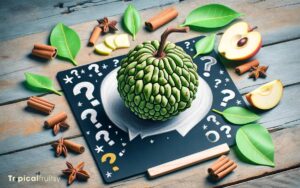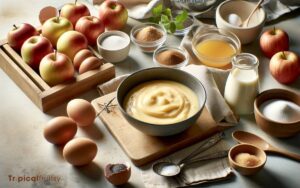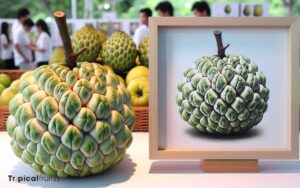How to Ripe Custard Apple? 5 Easy Steps!
To effectively ripen a custard apple, select a mature yet firm fruit and place it in a warm area with ample airflow. To hasten ripening, store the fruit in a paper bag with a banana, which releases ethylene gas.
Gently press the custard apple to test for ripeness; a slight give indicates a ready-to-eat, creamy interior. Once ripe, refrigerate the custard apple to preserve its peak freshness and taste.
Here are some quick steps:
A custard apple placed in a paper bag with a banana at room temperature can ripen faster than one left on the countertop.
Ripe custard apples offer a delightfully creamy texture and tropical flavor, ideal for a nutritious snack or exotic dessert.
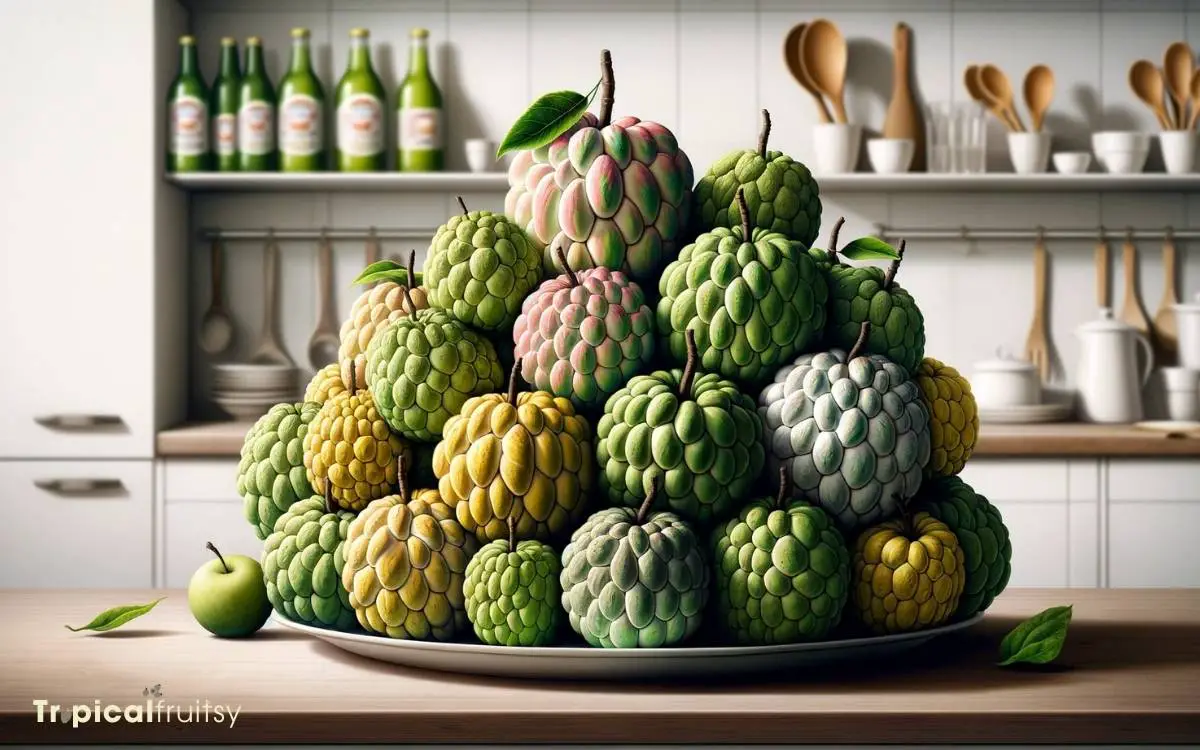
Key Takeaway
Understanding Custard Apples
I’ve found that custard apples, also known as sugar-apples or sweetsops, are tropical fruits with a unique, creamy texture and sweet flavor when fully ripe. They belong to the Annona family and are scientifically termed Annona squamosa.
This fruit’s maturation process is crucial for developing its characteristic taste and texture. The ripeness is indicated by a slight softness to touch and a change in skin color from green to a yellowish hue.
Custard apples contain numerous seeds enveloped in a fleshy, custard-like pulp. They’re rich in vitamins C and B6, magnesium, and potassium.
To ensure optimal consumption, it’s essential to understand the ripening stages and signs, as premature fruits can be hard with an astringent taste, while overripe ones may ferment and deteriorate rapidly.
Step 1: Selecting the Right Fruit
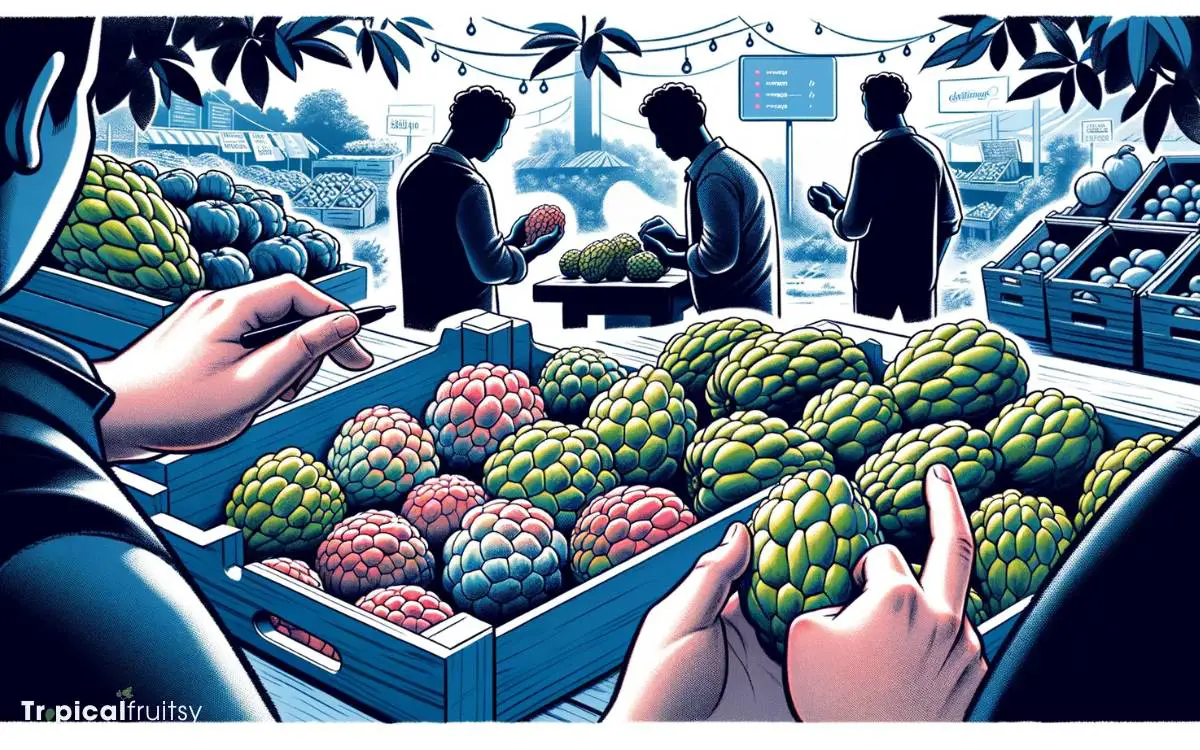
In my analysis of custard apple ripeness, I first assess the skin’s firmness, noting that optimal ripeness correlates with a slight give under gentle pressure.
I then scrutinize the fruit’s coloration, searching for a uniform hue as an indicator of even ripening.
These preliminary checks are critical for selecting a fruit that’s on the cusp of peak flavor and texture.
Skin Firmness Check
When selecting a custard apple, I check the skin’s firmness to gauge its ripeness. The skin should yield slightly under gentle pressure, indicating the internal flesh is softening and approaching optimal sweetness.
It’s crucial to understand that the pericarp, or fruit wall, undergoes physiological changes as the custard apple matures.
Here are key points I consider:
- The stage of pre-climacteric firmness, which suggests that the fruit is unripe.
- Where the skin begins to soften, indicating the onset of the climacteric rise in ethylene production.
- Post-climacteric softness, a state where the fruit is ripe enough for consumption but not overly soft, which could signal overripeness or spoilage.
This tactile assessment provides a reliable method for selecting fruit that will ripen to perfection.
Uniform Color Inspection
Beyond the skin’s firmness, I also examine the uniformity of the custard apple’s color to assess its ripeness. A mature custard apple should exhibit a consistent hue throughout its surface.
I’m looking for a color transformation from green to a pale, yellowish-green, or even a brownish tinge, depending on the variety.
This color shift is a biochemical indicator of the internal changes in sugar concentrations and acidity, correlating with the ripening process.
To make the details clearer, here’s a table that I often refer to:
| Color Stage | Ripeness Indicator |
|---|---|
| Dark Green | Underripe |
| Green | Maturing |
| Yellow-Green | Nearly Ripe |
| Brown Spots | Ripe |
| Blackened | Overripe |
These visual cues are vital for determining the perfect time to enjoy a custard apple at its peak flavor and texture.
Step 2: Ideal Ripening Conditions
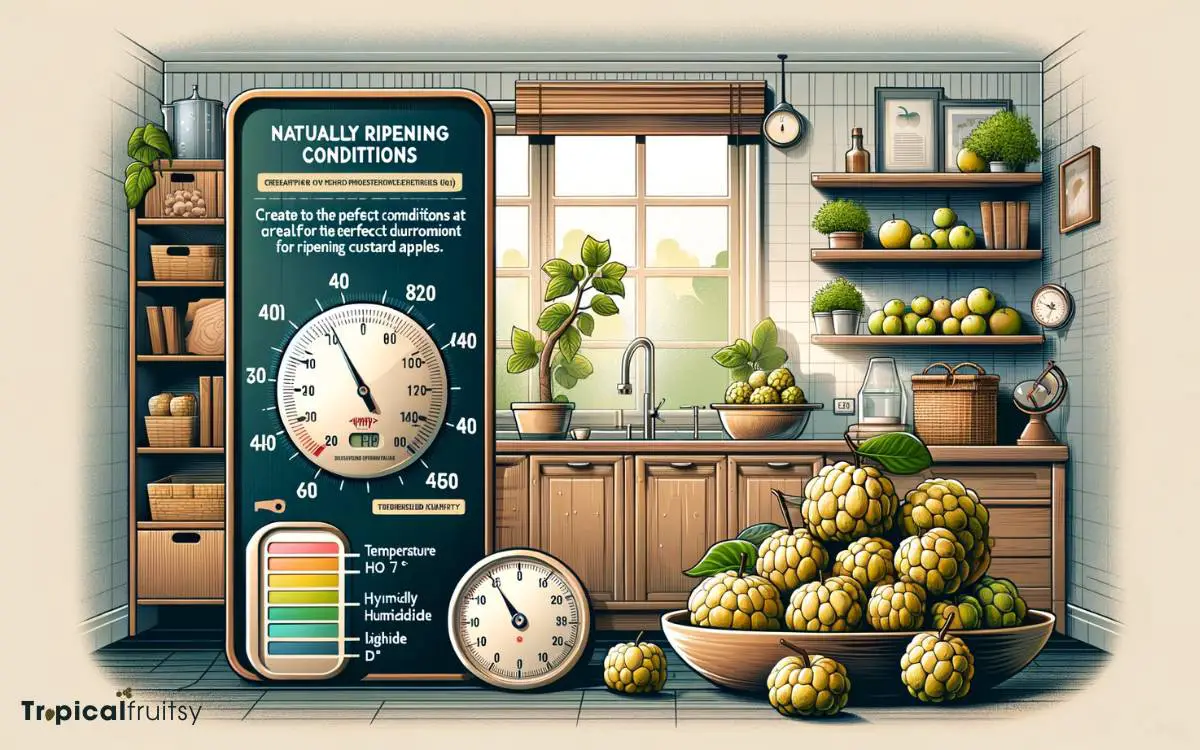
I’ve found that several key conditions must be met to ensure the perfect ripeness of a custard apple.
The ripening process is influenced by a combination of temperature, humidity, and ethylene exposure. These factors can significantly affect the quality and texture of the fruit.
Ideal conditions include:
- Temperature: Maintain a consistent range between 20°C to 25°C; excessive heat can lead to uneven ripening and potential spoilage.
- Humidity: Aim for moderate humidity levels, around 85-90%, to prevent dehydration and maintain fruit plumpness.
- Ethylene Exposure: Utilize ethylene, a natural ripening agent, in a controlled environment to encourage uniform ripening.
Step 3: Ethylene Gas Acceleration
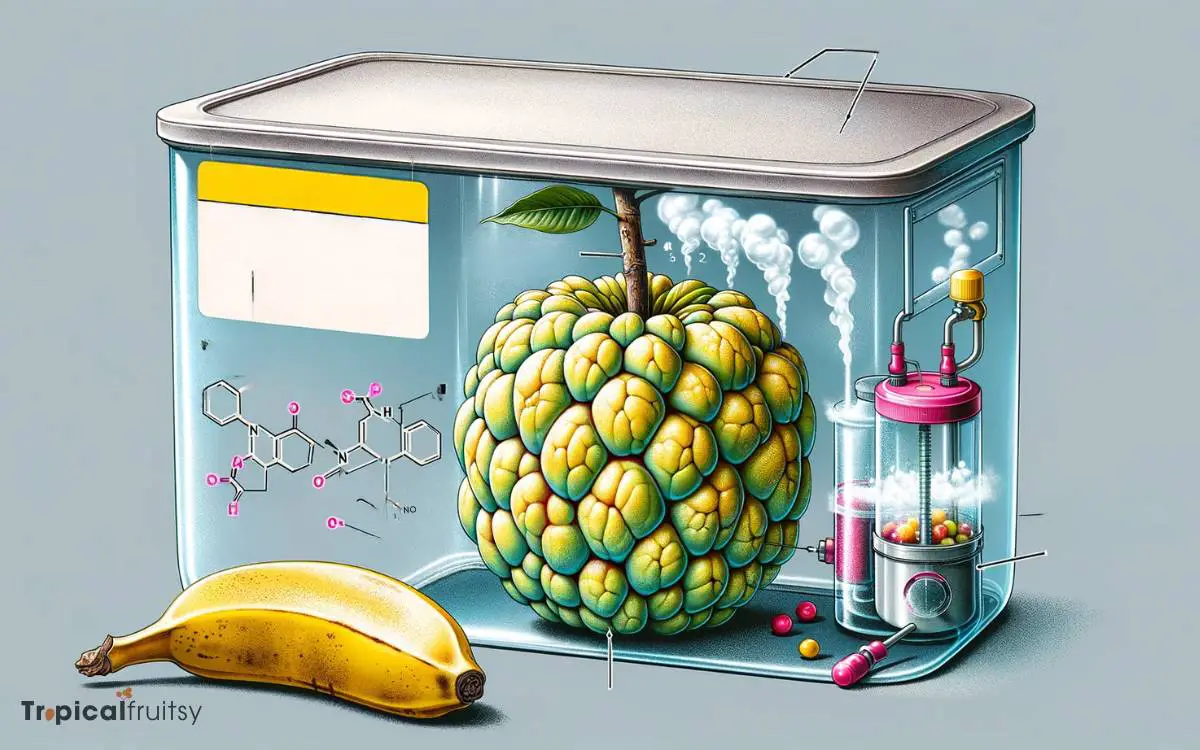
To accelerate the ripening of custard apples, I introduce ethylene gas into the storage environment, a technique that mimics the fruit’s natural maturation signals.
Ethylene, a hydrocarbon gas, plays a pivotal role in the ripening process. It acts as a hormone within the plant tissues, stimulating the conversion of starches to sugars, the degradation of chlorophyll, and the softening of the fruit.
I carefully regulate the concentration of ethylene, as excessive exposure can lead to uneven ripening and reduce the fruit’s shelf life.
I ensure the storage area is well-ventilated, to prevent the accumulation of carbon dioxide, which can inhibit ethylene’s effectiveness.
Utilizing this method, I’m able to hasten ripening, delivering custard apples that are uniformly succulent and ready to enjoy in a shorter time frame.
Can Ripe Custard Apples be Used to Make Juice?
Yes, ripe custard apples can be used to make delicious custard apple juice. To prepare a refreshing custard apple juice recipe, simply scoop out the flesh, remove the seeds, and blend it with water. Strain the mixture and add some honey or sugar to taste. Enjoy this nutritious and tasty drink!
Step 4: Checking for Ripeness
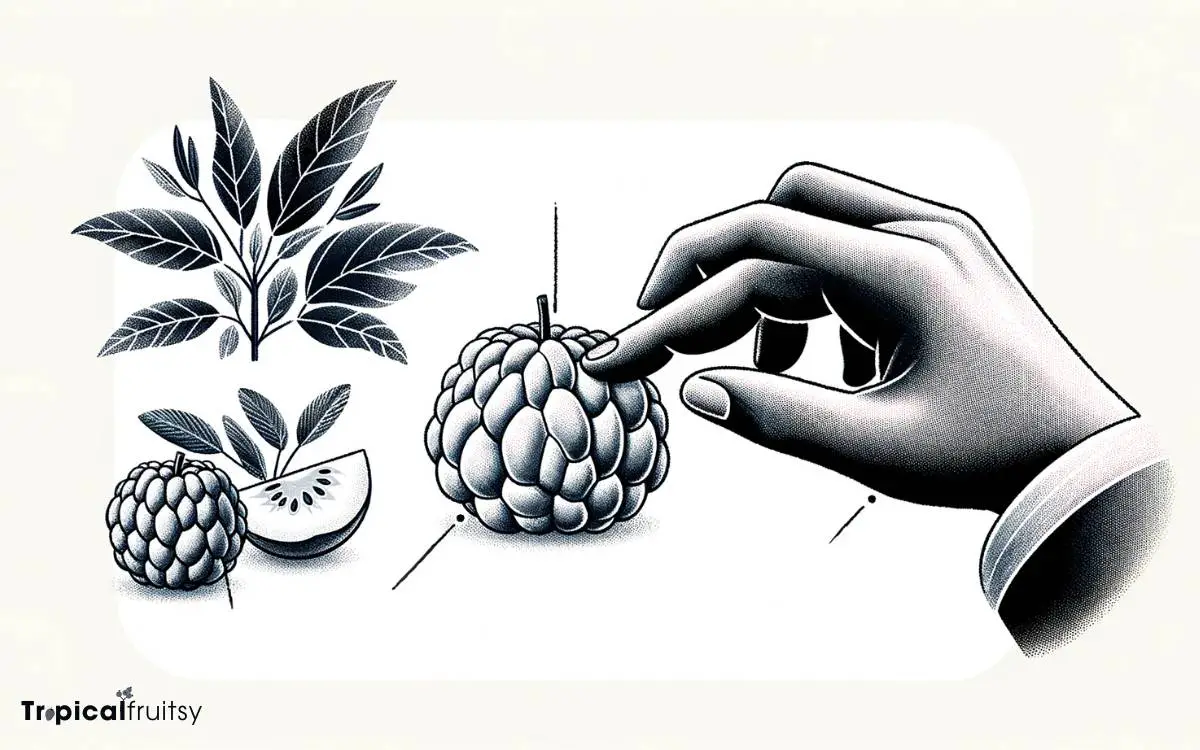
After applying ethylene gas, I check the custard apple’s ripeness by gently pressing the skin to feel for a slight give.
This method, known as the tactile assessment, is a reliable indicator of maturity. The skin’s elasticity usually correlates with the softening of the internal flesh, which signifies ripening.
However, to ensure accuracy, I observe additional factors:
- Aroma: A ripe custard apple emits a sweet, tropical fragrance that becomes more pronounced as the fruit matures.
- Color change: The skin transitions from a vibrant green to a duller hue, often with a yellowish tinge.
- Stem detachment: The ease with which the stem separates from the fruit can also indicate ripeness; it should come away cleanly in fully ripe fruit.
These markers provide a comprehensive understanding of the fruit’s readiness for consumption.
Step 5: Storing Ripe Custard Apples
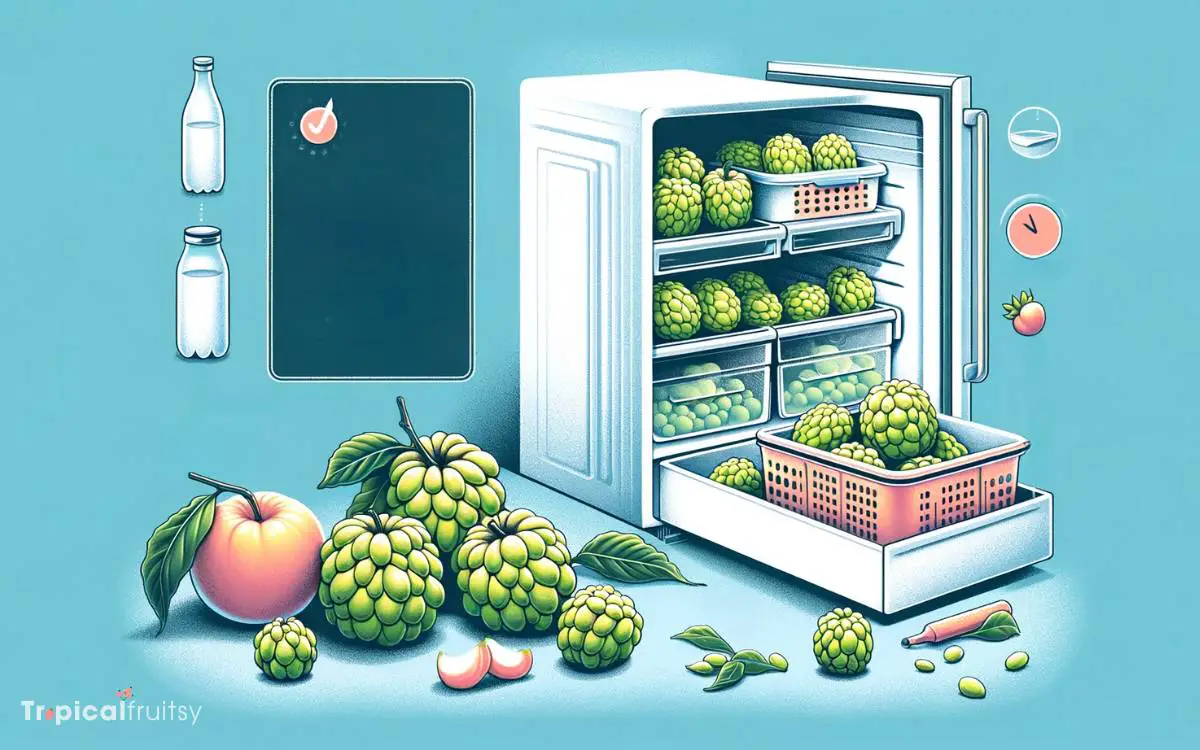
Once my custard apples reach peak ripeness, I store them in the refrigerator to prolong their freshness. The cold environment slows down the metabolic processes that lead to over-ripening and decay.
Ideally, I place them in the crisper drawer, which offers a slightly more humid environment compared to the rest of the refrigerator. This humidity is crucial as it prevents the dehydration of the fruit.
However, it’s imperative to avoid excess moisture which can promote fungal growth and cause the fruit to spoil.
If I’m dealing with multiple custard apples, I ensure they’re not stacked on top of each other to prevent bruising.
Each apple should be inspected for any signs of damage or rot before storage, as one spoiled fruit can accelerate the deterioration of others nearby.
Conclusion
Mastering the art of ripening custard apples is a culinary alchemy, turning these green gems into a luscious indulgence.
By harnessing ethylene’s magic and providing the perfect climatic embrace, you can easily spot that moment of peak ripeness, as the fruit yields to a gentle pressure.
Once ripe, treat these treasures like gold, storing them with care. Embrace the science of ripening and relish in the heavenly sweetness of perfectly matured custard apples.


